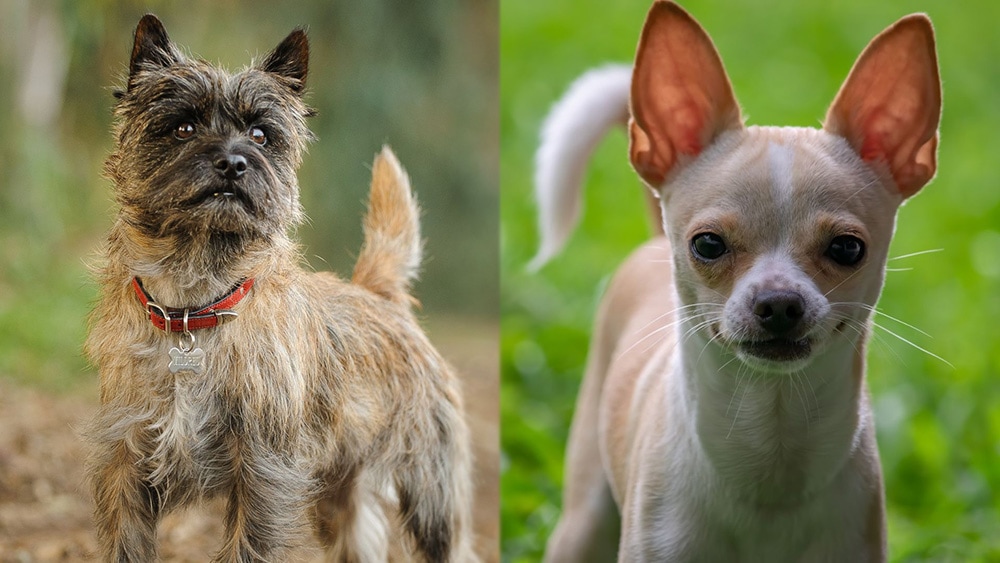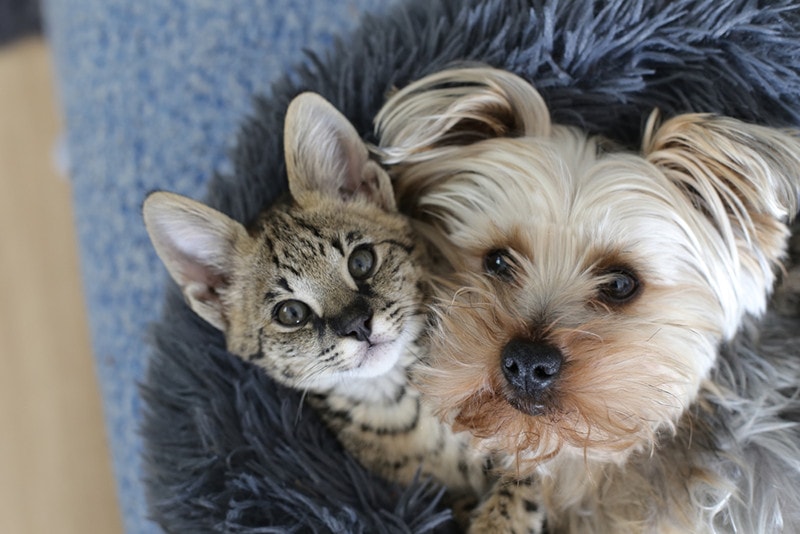Toxirn (Cairn Terrier Chihuahua Mix): Info, Pictures, Temperament & Traits
Updated on

Click to Skip Ahead
Toxirns are adorable dogs with a Cairn Terrier parent and a Chihuahua parent. As a mixed breed, these canines aren’t nearly as set in stone as other dog breeds. They tend to vary substantially, even among the same litter. Their size can vary, for instance, but they are always on the smaller side. They also have a relatively varying coat, which may be rough or smooth.
In most cases, these dogs are lively and alert. They can be pretty yappy, which can be a problem for dog owners who live in apartments or just don’t want to deal with the noise. However, they can also be incredibly affectionate, making them great family dogs.
| Height: | 6–12 inches |
| Weight: | 5–15 pounds |
| Lifespan: | 12–15 years |
| Colors: | Brown, black, white, brindle, and more |
| Suitable for: | Great for families in need of a smaller dog, such as those in apartments or cities |
| Temperament: | Energetic, yappy, affectionate |
It’s important that you accept some level of randomness with this dog breed. You may see plenty of cute Toxirn pictures online, but there is a chance that your puppy won’t look anything like them. You won’t know what you’re getting until your puppy is older, either.
Toxirn Characteristics
Toxirn Puppies
Toxirn puppies are often exceptionally small, which also makes them very adorable. However, their smaller size comes with some challenges. For instance, they tend to be much more easily injured, especially when they are very young. Therefore, they may not be a great option for homes with small children, where the chance of them getting injured goes up even more.
They can vary widely, even as puppies, as they are a mixed breed. Some are very playful and intelligent, while others may be more laid back. Generally, they are very alert and energetic—traits that they carry into adulthood.
Unlike some other mixed breeds, they tend to be relatively rare. Therefore, you often have to purchase them from a qualified breeder.

Temperament & Intelligence of the Toxirn
Toxirns can vary widely in their intelligence and temperament because they are a mixed breed. However, they tend to be pretty energetic and alert, like both of their parent breeds. While they’re smaller, they still need exercise each day to prevent hyperactivity. They’re usually pretty courageous, which can make them easier to socialize.
However, these dogs can be prone to “small dog syndrome,” which is a collection of behavioral problems common in smaller breeds. Often, these problems arise from how the breed is trained and socialized. It’s important that you allow them to explore the world and carry them as little as possible. Otherwise, they may lack confidence, which can lead to behavioral issues.
Toxirns tend to be very interactive and people-centered. They will spend their time following you around the house and asking for attention. Socialization and training are both important to ensure your Toxirn learns boundaries and self-control.
While not necessarily the smartest breed out there, Toxirns are plenty smart to learn commands. They do tend to be a bit independent, though, so they may not listen to those commands as much as more obedient dogs. Start training early to help build that obedience muscle. Positive reinforcement works well for this breed, especially when the reward is plenty of attention.
Are These Dogs Good for Families? 🏡
Toxirns are bred to be companion animals. Therefore, they often work well for many families. However, there are some things you should keep in mind, as these dogs aren’t necessarily great for every family out there.
These dogs are relatively small, which can be a huge boon for those in apartments or who simply can’t handle a bigger dog. However, this also means that they’re more prone to injury if stepped on. Of course, as a mixed breed, these dogs vary widely. Some are lively and alert, but others may be more laid back.
Their independence can also be a problem, especially for new dog owners. We highly recommend puppy classes, which provide socialization and an introduction to training.
Does This Breed Get Along with Other Pets? 🐶 😽
A Toxirn’s ability to get along with other pets largely depends on the dog’s socialization. Sometimes, these dogs will get along well with others. Other times, they may not be socialized enough to accept other dogs in their space. We recommend introducing them to dogs as early as possible. Group puppy classes are exceptionally helpful for this!
Cairn terriers are known for being social and getting along with just about any canine. However, Chihuahuas can be reserved with other canines. Sometimes, they may even develop territorial tendencies.
Things to Know When Owning a Toxirn
Food & Diet Requirements 🦴
Toxirns don’t need special nutrition in most cases. These canines do good on just about any high-quality food on the market. Of course, if you choose to feed dry food, be sure to select an option made for smaller breeds. The food should also meet the nutritional standards of the AAFCO, which lays out the nutritional requirements for dogs in the United States.
When your dog is a puppy, select a food for small-breed puppies. This food should be small enough to fit in their mouth, and it also provides the correct nutrition for these growing puppies.
Always control how much food your dog eats. These smaller dogs can begin to feel the negative health effects of being overweight much sooner than bigger dogs. Portion control is important, especially if your dog is on the less active side.
When young, you may need to feed these dogs as many as four or five times a day. Due to their smaller size, these canines often have a hard time maintaining a proper blood sugar level. Frequent feeding can help prevent hypoglycemia, which can cause seizures or even death.
Exercise 🐕
This breed tends to be pretty energetic. However, a lot of this energetic nature is innate and not necessarily due to their need for tons of exercise. They will be energetic even when their exercise needs are met. Training can help make them a bit more controllable, but some may just be innately hyperactive.
Toxirns typically need minimal exercise. A daily game of fetch, if your dog will play, is often enough. A short walk in nice weather also works, though these dogs typically don’t like being outside when it is wet or cold. Luckily, their smaller size allows them to meet their exercise needs indoors, if necessary.
You can also consider some more active tricks as exercise. Teaching your dog to sit, stay, and then come from the other side of the house can absolutely count as exercise. You can also play games like hide-and-seek, which uses this same concept.
https://www.instagram.com/p/wpRr89gHJr/?utm_source=ig_web_copy_link&igsh=MzRlODBiNWFlZA==
Training 🦮
These canines require training, just like any other dog breed, and should learn obedience commands just like any other canine, including how to walk on a leash. Many of the behavioral problems associated with smaller breeds come from too much carrying and not enough training. Avoid problem behaviors later on by focusing on training as soon as you bring your puppy home.
These dogs aren’t the easiest to train, but they aren’t the hardest, either. You’ll need to train them often and in many different locations to build their obedience muscle. Instead of just checking off a list of cues to cover, focus on practicing those cues in distracting situations, too.
Be very consistent with your expectations with this breed. Be sure to always have the same boundaries and rules and discuss these with everyone else in the family. Having everyone on board and using the same cues will help the dog learn faster.
Socialization is essential for this breed and should begin as early as possible. Introduce your dog to other canines, children, and interesting places early and regularly. This process helps prevent fear and aggression later on.
Don’t forget to train these smaller dogs to walk on a leash, as well. While they can easily be carried from place to place, this doesn’t allow them to interact with the world.
Grooming ✂️
The exact grooming needs of this breed depend on the coat type they inherit. Cairn terriers and Chihuahuas have slightly different coats, so their grooming needs vary a little bit.
Generally, these dogs require some brushing regularly, especially if their coat is rougher and longer. However, those with very short coats likely only need brushing once a week to control shedding and help keep their coat clean. Those with longer fur may need brushing up to three times a week to prevent tangles.
You shouldn’t need to bathe these dogs often. A brush can do more to remove dust than you may think. Plus, bathing can irritate their skin and dry it out, causing more shedding.
Regular teeth brushing is absolutely necessary, as it helps prevent teeth problems. You may also need to clean their ears, though this isn’t necessary for every dog. If you notice earwax and dirt built up in their ears, then you absolutely need to clean them with a damp cotton ball. Never shove anything into your dog’s ears, though.
Health and Conditions ❤️
As a mixed breed, these dogs are pretty healthy. These dogs inherit traits from both of their parents, which prevent genetic conditions from occurring. Unlike purebred dogs, recessive traits are less likely to be inherited to cause health issues.
That said, these dogs are still prone to some health problems. Patellar luxation is the most common condition and involves the kneecap dislocating from its usual position. This occurs in many small breeds and can cause lameness. Dental problems can occur, especially if you don’t keep up with teeth brushing. Because their mouths are so small, crowding is more of a problem.
These canines may also be prone to allergies. Often, these manifest as skin issues or ear infections. Often, dogs become extremely itchy, eventually biting sores on their paws or rump. Identifying allergies can be complicated, but once they are discovered, it is a lot simpler.
- Eye issues
- Allergies
- Obesity
- Patellar luxation
- Dental problems
- Allergies
- Tracheal collapse
- Hypoglycemia
- Legg-Calvé-Perthes disease
Male vs. Female
These dogs do not vary much according to gender. Males and females are practically the same, especially if they are spayed and neutered. Unlike other breeds, there is no size difference, as these dogs are so small to begin with. Plus, temperament differences aren’t proven, either.
3 Little-Known Facts About the Toxirn
1. They’re very rare.
While some mixed breeds are becoming more and more popular, this breed doesn’t fall into that category. Instead, they’re much rarer and difficult to find than most dog breeds out there. Locating a breeder that specializes in them can be very difficult.
2. Toxirns can vary considerably.
As a mixed breed, you never know what you’re going to get with these little dogs. They can inherit any trait from either parent, leading to a huge variety of possible traits.
3. They’re often very lively dogs.
Despite being smaller, these dogs are exceptionally lively, energetic dogs. They tend to be very hyperactive and added exercise doesn’t always correct this problem.
Final Thoughts
If someone is looking for a small, energetic canine, a Toxirn can be a great option. This mixed breed can vary widely, though, so puppies tend to vary considerably, even within the same breed. Some are more laidback, while others may be more active.
Luckily, these dogs tend to be pretty healthy, and their smaller size makes them straightforward to exercise. However, unluckily, they’re exceedingly rare. There aren’t many breeders that specialize in them, making finding a puppy to adopt challenging.
Featured Image Credit: (L) everydoghasastory, Shutterstock | (R) Jairo Alzate, Unsplash














